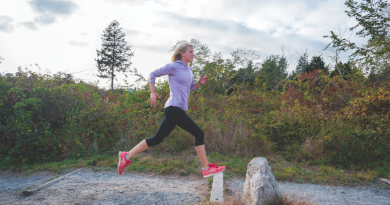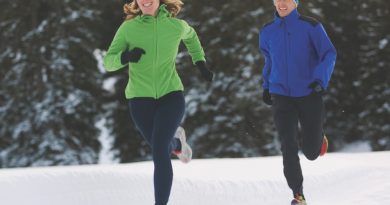If the shoe fits…
About Christy:
Christy Lynn spent two years working in specialty running stores in Brooklyn, N.Y. and Vancouver, B.C. before joining a specialty running company (Brooks) as a technical representative. She then became a biomechanics guru for two-plus years, traveling across western Canada (Alberta and British Columbia) educating runners and running shops about how footwear affects natural biomechanics and can be used to relieve and prevent some of the most common running injuries. She also helped coach numerous running groups for longer distance races.
While she happens to be the advertising manager of Vermont Sports and assistant publisher of Addison Press Inc. in Middlebury, as part of the family business, she’s also our go-to person on all things about running. She loves to run and keeps tabs on all the changes and developments in the running industry, which she worked in for five years.
Picking a pair of shoes is hardly a matter of picking a pair off the shelf. To avoid running injuries and to feel more comfortable while running, getting a good pair of shoes that fit is one of the most important decisions you’ll make as a runner.
Picking the right pair of shoes is worth the effort, says Christy Lynn, who spent four years in specialty running stores in Brooklyn, N.Y., then another two-plus years as a technical representative for a specialty running shoe company in western Canada, primarily British Columbia and Alberta.
Not thinking the right shoe matters, she adds, not only can lead to common running injuries but can take the joy out of the sport.
“Most people can find a comfortable running shoe that fits their running style,” she say, adding that it takes a fairly sophisticated understanding of one’s own body biomechanics, information that can be gained online or at a specialty running shoe store that focuses on proper fit. “And, most times,” Lynn says, “the right pair of shoes can really get you to that place of comfort within a running routine.”
Different strides for different runners
Everyone runs differently and Lynn is quick to point out some of the ways. Just like everyone’s body is different, everyone has a different set of natural biomechanical positions that they go to naturally when they move, she says.
Here are just a few factors at work:
- Hips can be angled in different directions, which may push the runner’s center of gravity forward or back.
- Slight leg length discrepancies can tilt a runner more to one side.
- Flat feet versus high arches.
- Tight versus loose hips.
To account for the wide variety of body types, top running shoe companies employ biomechanical engineers to study how different shoes affect the natural way runners move. The objective? To develop shoes that address the needs of runners so they move efficiently and reduce running injuries.
How do you run?
To properly fit runners, the most experienced shops rely on video analysis of a customer walking or running to decide what kind of shoe would best suit their biomechanics. Runners can also learn about how they run by looking at the wear patterns on their shoes. Many runners can find themselves in one of these categories:
- Pronation shows a natural wear pattern at the balls of the feet and a portion of the heel, caused by the natural inward roll following the heel striking the ground. Runners who have a normal amount of pronation in their run, look to “neutral” shoes.
- Over-pronation shows excessive wear on the inside edge of the shoe, an exaggerated form of that natural inward roll. Over-pronators need stability or motion control shoes.
- Under-pronation (also called supination) shows excessive wear on the outside edge of the shoe, caused by insufficiently reducing impact while running. Runners who under-pronate should look for neutral running shoes with lots of cushioning.
Lynn says once a runner determines how they run, it becomes easier to find a pair of shoes that addresses their needs.
Shoes are designed around how a runner moves, beginning with where the foot hits the ground, she said. This begins with a “crash pad,” a piece of lowest-density cushioning where the runner’s foot is likely to strike first. This can be squarely on the heel or more forward if the runner lands on their forefeet. Shoes also feature a flex pattern that allows the shoe and the foot inside it to flex naturally.
“It’s about following a path of least resistance,” Lynn says.
Reducing the risks
When a runner’s strike is correctly aligned, that runner is likely to avoid the five most common chronic injuries associated with running.
- Plantar fasciitis refers to the inflammation of the plantar fascia, a thick band of connective tissue that connects the bone of the heel to the base of the toes. It can be caused by improper support through the arch of the foot.
- Achilles tendonitis is the inflammation or tear in the Achilles tendon, which connects the back of the heel to the calf muscle.
- IT Band syndrome is the inflammation of a thick connective fascia that wraps around the outside of the knee and runs to the hip.
- Runners knee refers to pain in the area under the kneecap where the kneecap connects with the thighbone.
- Shin splints are common injuries for athletes rapidly increasing their training. Over-pronation of the feet is also a risk factor for developing shin splints, as inward rotation of the foot and ankle pull the muscles away from the tibia bone.
All of these injuries can be avoided with a properly fitted pair of running shoes, and proper training habits.
If the shoe fits…
The most important fit in the shoe is the heel, Lynn says, since that’s where the under- or over-pronation originates. The shoe should also be wide enough to allow the muscles in the front of your foot to work. If a shoe is too narrow, the muscles won’t be able to function to their fullest ability.
A third point of recognizing a well-fitting shoe is what Lynn calls “the transition point,” a point on the sole – usually under the arch – that encourages motion forward. Many people recognize they’ve found a shoe that truly works for them when that area aligns with their foot. If a person’s initial point of contact is more on their forefoot than their heels, this point will not be as distinct or important.
“It will substantially differ between support shoes and neutral shoes,” she says.
A support shoe offers maximum support for a foot that over-pronates while a neutral shoe is designed for runners with normal pronation in their foot as they run.
A final point of shoe fitting is recognizing whether you’re what Lynn calls “a gripper or a flexer,” which has more to do with your toes. Most people will either subconsciously flex their toes up or grip them into the foot-bed at each strike. Runners that identify as a “gripper” should look for a shoe that turns upward at the toe to allow the foot to push off. “Flexers” should find a wider shoe that will let the toes spread like they want.
When you’re trying on a pair of shoes, Lynn says, it’s important to walk and run as you normally would and resist the urge to change your strike pattern or length of stride.
“Trying on shoes is not the time to change your running habits or stride,” she says. “Just do what you normally do and get the shoe that fits you.”
Also important: don’t be so picky about color.
A pair of running shoes should feel and fit comfortably as soon as they come out of the box. You will not have to run miles to break them in, Lynn says, to which South Burlington coach and runner Moe Brown agrees.
“I often hear people say ‘they feel uncomfortable now, but I’m going to break them in,’” Brown says. “But if they don’t feel good right away, then they’re not going to be good for you.”
Time for another pair?
Every top brand of running shoe uses a patented cushioning system, Lynn says. Nike uses Air, Adidas has Boost, Asics employs Gel and Brooks now designs shoes with BIOMOGO Technology. That’s a lot of variety and Lynn cautions that some of it can be “gibberish science,” but consistent runners need to keep track of how long their shoes last so they aren’t running on shoes that have outlasted their performance.
For consistent runners, Lynn says a pair of shoes can last between 400 and 500 miles before the shoes’ dampening properties are lost. When the padding and treads flatten, she says, the jarring feeling in your joints will let you know it’s time for a new pair.


